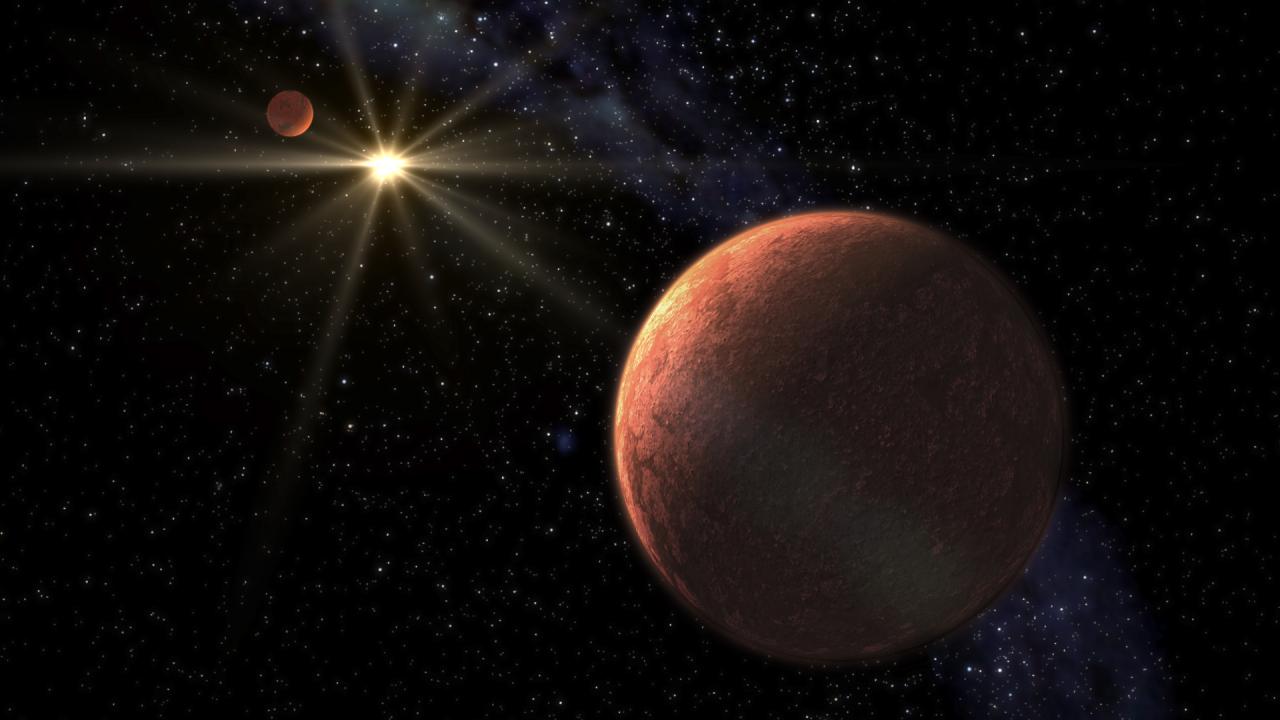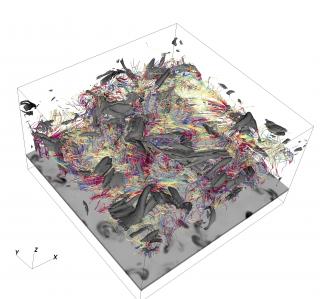Subvenciones relacionadas:
General
Se investigan los procesos que conducen a la formación de estrellas de baja masa, enanas marrones y exoplanetas y caracterizar las propiedades físicas de estos astros en varias etapas evolutivas. Las estrellas de muy baja masa y las enanas marrones son probablemente los objetos más numerosos de nuestra Galaxia, pero no por ello están suficientemente bien establecidas sus propiedades. En particular, los objetos subestelares constituyen uno de los grupos más difíciles de estudiar desde el punto de vista observacional dada su baja luminosidad intrínseca. Se pretende establecer la frecuencia, multiplicidad y distribución espacial de estrellas ultrafrías y objetos subestelares en la vecindad del Sol y en regiones de formación estelar y cúmulos cercanos con el fin de proporcionar información sobre los mecanismos que los originan, caracterizar sus propiedades ópticas e infrarrojas, y establecer relaciones entre sus propiedades espectrales, masas y luminosidades. Se hace especial énfasis en empujar la frontera de detección hacia los objetos de menor masa, bien sea como objetos ligados por atracción gravitatoria a otros, o flotando libremente en el espacio interestelar. Los objetos menos masivos también suelen ser los de menor luminosidad intrínseca y temperaturas superficiales más frías por lo que entrañan notable dificultad de detección por medio de imagen directa. Sin embargo, la detección directa permite una caracterización fotométrica y espectroscópica mucho más completa y una mejor determinación de sus propiedades físicas y químicas. También se pretende investigar la presencia de exoplanetas en estrellas de baja masa empleando técnicas de medida de velocidad radial con muy alta precisión y técnicas de muy alta resolución espacial. Se trabaja en el desarrollo de espectrógrafos ultraestables para grandes telescopios y de sistemas de imagen ultrarrápida. Con los primeros es posible lograr la detección de planetas con masas similares a la de la Tierra en estrellas de tipos G, K y M un objetivo que se persigue es establecer la frecuencia de estos planetas en las estrellas de la vecindad solar y caracterizar las propiedades de los sistemas planetarios a los que pertenecen.
Miembros
Resultados
- La secuencia visible y infrarroja de las enanas de tipo L de 10 Myr de edad en la asociación OB mas cercana al Sol, Upper Scorpius
- El limite estelar/subestelar del cumulo más cercano al Sol, las Hiades
Actividad científica
Publicaciones relacionadas
-
Radio emission in a nearby, ultra-cool dwarf binary: A multifrequency study
Context. The substellar triple system VHS J125601.92−125723.9 (hereafter VHS 1256−1257) is composed of an equal-mass M7.5 brown dwarf binary and an L7 low-mass substellar object. In Guirado et al. (2018, A&A, 610, A23) we published the detection of radio emission at 8.4 GHz coming from the central binary and making it an excellent target for
Climent, J. B. et al.Fecha de publicación:
42022 -
Metallicities in M dwarfs: Investigating different determination techniques
Deriving metallicities for solar-like stars follows well-established methods, but for cooler stars such as M dwarfs, the determination is much more complicated due to forests of molecular lines that are present. Several methods have been developed in recent years to determine accurate stellar parameters for these cool stars (T eff ≲ 4000 K)
Passegger, V. M. et al.Fecha de publicación:
22022 -
Discovery and mass measurement of the hot, transiting, Earth-sized planet, GJ 3929 b
We report the discovery of GJ 3929 b, a hot Earth-sized planet orbiting the nearby M3.5 V dwarf star, GJ 3929 (G 180-18, TOI-2013). Joint modelling of photometric observations from TESS sectors 24 and 25 together with 73 spectroscopic observations from CARMENES and follow-up transit observations from SAINT-EX, LCOGT, and OSN yields a planet radius
Kemmer, J. et al.Fecha de publicación:
32022 -
A multi-planetary system orbiting the early-M dwarf TOI-1238
Context. The number of super-Earth and Earth-mass planet discoveries has increased significantly in the last two decades thanks to the Doppler radial velocity and planetary transit observing techniques. Either technique can detect planet candidates on its own, but the power of a combined photometric and spectroscopic analysis is unique for an
González-Álvarez, E. et al.Fecha de publicación:
22022 -
TOI-2285b: A 1.7 Earth-radius planet near the habitable zone around a nearby M dwarf
We report the discovery of TOI-2285b, a sub-Neptune-sized planet transiting a nearby (42 pc) M dwarf with a period of 27.3 d. We identified the transit signal from the Transiting Exoplanet Survey Satellite photometric data, which we confirmed with ground-based photometric observations using the multiband imagers MuSCAT2 and MuSCAT3. Combining these
Fukui, Akihiko et al.Fecha de publicación:
22022 -
The CARMENES search for exoplanets around M dwarfs. Diagnostic capabilities of strong K I lines for photosphere and chromosphere
There are several strong K I lines found in the spectra of M dwarfs, among them the doublet near 7700 Å and another doublet near 12 500 Å. We study these optical and near-infrared doublets in a sample of 324 M dwarfs, observed with CARMENES, the high-resolution optical and near-infrared spectrograph at Calar Alto, and investigate how well the lines
Fuhrmeister, B. et al.Fecha de publicación:
12022 -
TOI-2257 b: A highly eccentric long-period sub-Neptune transiting a nearby M dwarf
Context. Thanks to the relative ease of finding and characterizing small planets around M-dwarf stars, these objects have become cornerstones in the field of exoplanet studies. The current paucity of planets in long-period orbits around M dwarfs makes such objects particularly compelling as they provide clues about the formation and evolution of
Schanche, N. et al.Fecha de publicación:
12022 -
TOI-2285b: A 1.7 Earth-radius planet near the habitable zone around a nearby M dwarf
We report the discovery of TOI-2285b, a sub-Neptune-sized planet transiting a nearby (42 pc) M dwarf with a period of 27.3 d. We identified the transit signal from the Transiting Exoplanet Survey Satellite photometric data, which we confirmed with ground-based photometric observations using the multiband imagers MuSCAT2 and MuSCAT3. Combining these
Fecha de publicación:
122021Bibcode -
Rapid contraction of giant planets orbiting the 20-million-year-old star V1298 Tau
Current theories of planetary evolution predict that infant giant planets have large radii and very low densities before they slowly contract to reach their final size after about several hundred million years 1,2. These theoretical expectations remain untested so far as the detection and characterization of very young planets is extremely
Fecha de publicación:
122021Bibcode -
GTC/CanariCam Deep Mid-infrared Imaging Survey of Northern Stars within 5 pc
In this work we present the results of a direct imaging survey for brown dwarf companions around the nearest stars at the mid-infrared 10 micron range (λ c = 8.7 μm, Δλ = 1.1 μm) using the CanariCam instrument on the 10.4 m Gran Telescopio Canarias (GTC). We imaged the 25 nearest stellar systems within 5 pc of the Sun at declinations δ > -25° (at
Gauza, Bartosz et al.Fecha de publicación:
122021 -
TOI-1201 b: A mini-Neptune transiting a bright and moderately young M dwarf
We present the discovery of a transiting mini-Neptune around TOI-1201, a relatively bright and moderately young early M dwarf (J ≈ 9.5 mag, ~600-800 Myr) in an equal-mass ~8 arcsecond-wide binary system, using data from the Transiting Exoplanet Survey Satellite, along with follow-up transit observations. With an orbital period of 2.49 d, TOI-1201 b
Kossakowski, D. et al.Fecha de publicación:
122021 -
Diving Beneath the Sea of Stellar Activity: Chromatic Radial Velocities of the Young AU Mic Planetary System
We present updated radial-velocity (RV) analyses of the AU Mic system. AU Mic is a young (22 Myr) early-M dwarf known to host two transiting planets-P b ~ 8.46 days, ${R}_{b}={4.38}_{-0.18}^{+0.18}\ {R}_{\oplus }$ , P c ~ 18.86 days, ${R}_{c}={3.51}_{-0.16}^{+0.16}\ {R}_{\oplus }$ . With visible RVs from Calar Alto high-Resolution search for M
Cale, Bryson L. et al.Fecha de publicación:
122021 -
A young spectroscopic binary in a quintuple system part of the Local Association
Context. Double-lined spectroscopic (SB2) binaries allow us to obtain a direct determination of the masses of their components, which is essential to test stellar models. Although these objects only provide a lower limit for the mass, they are more abundant than their eclipsing counterparts as they are not as strongly limited by the inclination of
Cardona Guillén, Carlos et al.Fecha de publicación:
102021 -
Is the orbit of the exoplanet WASP-43b really decaying? TESS and MuSCAT2 observations confirm no detection
Up to now, WASP-12b is the only hot Jupiter confirmed to have a decaying orbit. The case of WASP-43b is still under debate. Recent studies preferred or ruled out the orbital decay scenario, but further precise transit timing observations are needed to definitively confirm or refute the period change of WASP-43b. This possibility is given by the
Garai, Z. et al.Fecha de publicación:
122021 -
The Rossiter-McLaughlin effect revolutions: an ultra-short period planet and a warm mini-Neptune on perpendicular orbits
Comparisons of the alignment of exoplanets with a common host star and each other can be used to distinguish among concurrent evolution scenarios for the star and the planets. However, multi-planet systems usually host mini-Neptunes and super-Earths, whose sizes make orbital architecture measurements challenging. We introduce the Rossiter
Bourrier, V. et al.Fecha de publicación:
102021 -
HD 22496 b: The first ESPRESSO stand-alone planet discovery
Context. The ESPRESSO spectrograph is a new powerful tool developed to detect and characterize extrasolar planets. Its design allows an unprecedented radial velocity precision (down to a few tens of cm s −1) and long-term thermomechanical stability. Aims: We present the first stand-alone detection of an extrasolar planet by blind radial velocity
Lillo-Box, J. et al.Fecha de publicación:
102021 -
A large sub-Neptune transiting the thick-disk M4 V TOI-2406
Context. Large sub-Neptunes are uncommon around the coolest stars in the Galaxy and are rarer still around those that are metal-poor. However, owing to the large planet-to-star radius ratio, these planets are highly suitable for atmospheric study via transmission spectroscopy in the infrared, such as with JWST. Aims: Here we report the discovery
Wells, R. D. et al.Fecha de publicación:
92021 -
Into the storm: diving into the winds of the ultra-hot Jupiter WASP-76 b with HARPS and ESPRESSO
Context. Despite swift progress in the characterisation of exoplanet atmospheres in composition and structure, the study of atmospheric dynamics has not progressed at the same speed. While theoretical models have been developed to describe the lower layers of the atmosphere, and independently, the exosphere, little is known about the intermediate
Seidel, J. V. et al.Fecha de publicación:
92021 -
The CARMENES search for exoplanets around M dwarfs. Spectroscopic orbits of nine M-dwarf multiple systems, including two triples, two brown dwarf candidates, and one close M-dwarf-white dwarf binary
Context. M dwarfs are ideal targets for the search of Earth-size planets in the habitable zone using the radial velocity method, and are attracting the attention of many ongoing surveys. One of the expected results of these surveys is that new multiple-star systems have also been found. This is the case also for the CARMENES survey, thanks to which
Baroch, D. et al.Fecha de publicación:
92021 -
Warm terrestrial planet with half the mass of Venus transiting a nearby star
In recent years, the advent of a new generation of radial velocity instruments has allowed us to detect planets with increasingly lower mass and to break the one Earth-mass barrier. Here we report a new milestone in this context by announcing the detection of the lowest-mass planet measured so far using radial velocities: L 98-59 b, a rocky planet
Demangeon, O. D. S. et al.Fecha de publicación:
92021



